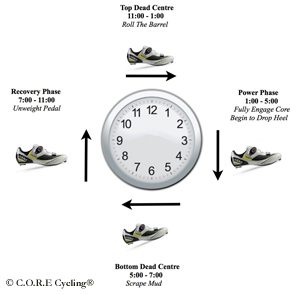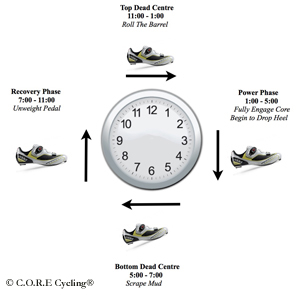there’s far more to pedal technique on a road bike than you’d think

When I first took up road cycling a bit over 10 years ago I thought that there wasn’t a great deal to learn about
pedal technique on a road bike, but I was wrong. There are plenty of skills to learn and central amongst them is the art of pedalling.
I’m no authority on this subject so I’ve borrowed some expert words that appear below. The key principle behind the technique is to pedal in nice smooth circles. Sounds easy, but there’s a little more to it.
This article was originally published on the now defunct women’s cycling website Women’s Cycling in Canada.
Focusing on a smooth, round stroke will actually help to produce more power per stroke. If you think about it, pushing and pulling connotes a linear trajectory, or at best pedalling a square. Instead, imagine the pedal stroke as a clock face.
The stroke is then divided into four distinct phases:
Top Dead Centre (12:00)
11:00 – 1:00
Imagine that your foot is on top of a barrel and you are rolling it forward allowing your foot to move across the top of the pedal stroke. Imagine your toes pushing towards the front of your shoe.
Power Phase
1:00 – 5:00
Fully engage your core, begin to drop your heel, relax the belly but engage the core by bringing your ribs to meet the hips. This will fully engage the core and provide a strong platform for your legs to push up against.
During the power phase many riders will rotate the pelvis forward as the knee is in the flexed position which results in a loss in power. It’s important to try to keep the hips square.
Begin to drop heel in this phase.
Bottom Dead Centre (6:00)
5:00 – 7:00
Begin this phase with the heel dropped. Drag the foot across the bottom of the stroke leading with the heel which engages the powerful muscles of the gluteus and hamstring group. It’s as if you’re scraping mud off your shoe. Imagine trying to lengthen the crank arm.
Recovery Phase
7:00 – 11-00
Help with the power phase by floating the foot on the pedal.
As you approach 10:00 imagine throwing the entire leg over the handlebars.
Practice the four phases on your trainer with a gear big enough to feel the entire stroke. If you have access to a power meter, try your old way of pedalling and then pedal full smooth circles (be sure to keep the cadence and gearing consistent with both efforts).

